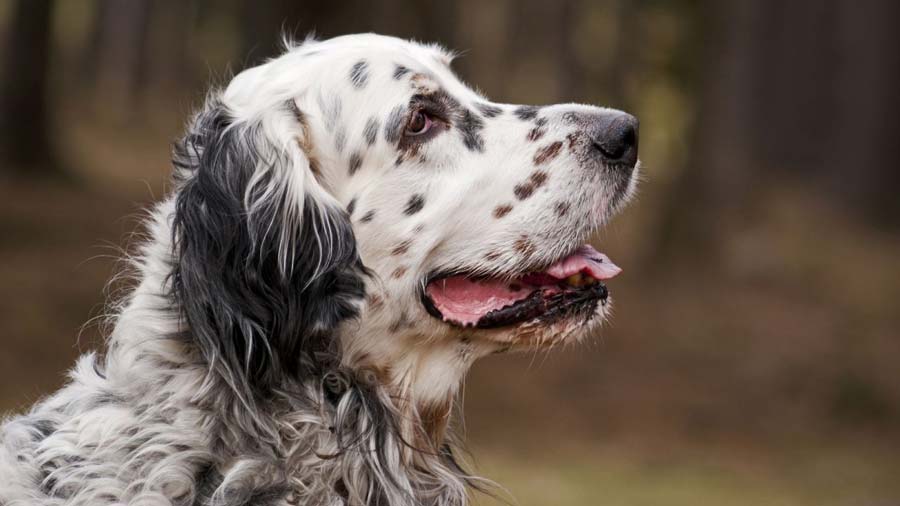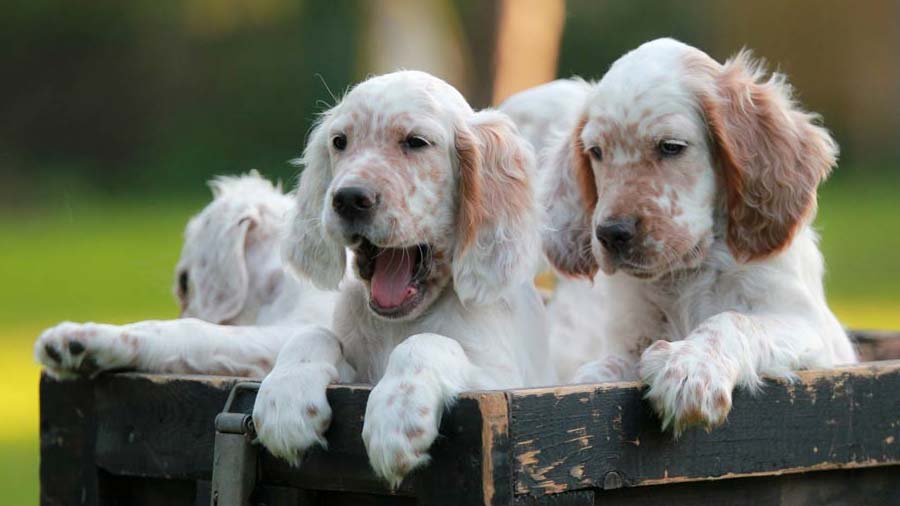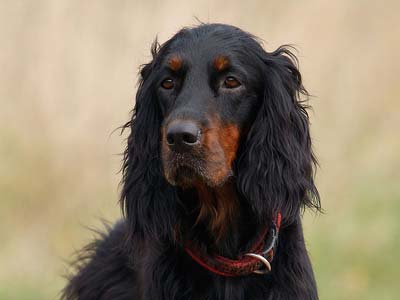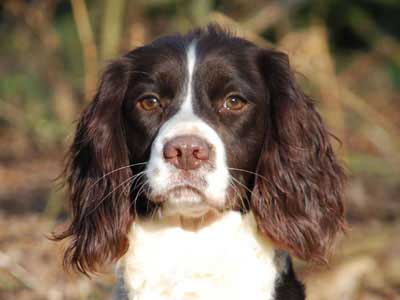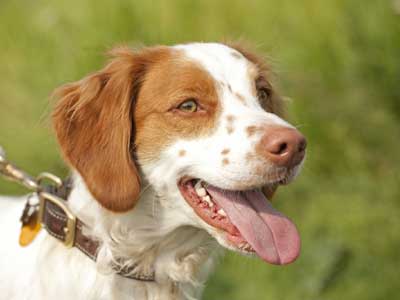English Setter
Breed Information |
|
|---|---|
| Popularity |
2022: #93 2021: #98 2020: #101 2019: #98 2018: #94 2017: #95 2016: #102 2015: #96 |
| Name | English Setter |
| Other names | Lawerack, Laverack, Llewellin (or Llewellyn) Setter |
| Origin |  United Kingdom United Kingdom |
| Breed Group |
Sporting (AKC:1884) Gun Dog (UKC) |
| Size | Large |
| Type | Purebred |
| Life span | 10-12 years |
| Temperament |
Strong Willed Mischievous Gentle Energetic Intelligent People-oriented |
| Height |
Male: 24-27 inches (61-69 cm) Female: 23-26 inches (58-66 cm) |
| Weight |
Male: 55-80 pounds (25-36 kg) Female: 45-70 pounds (20-32 kg) |
| Colors |
Blue Belton Blue Belton & Tan (Tri-color) Lemon Belton Liver Belton Orange Belton |
| Litter Size | 4-6 puppies |
| Puppy Prices |
Average $1000 - $1500 USD The average price of an English Setter puppy is between $1,000 - $1,500. Prices all depend on the pedigree of the puppies, the amount of work the breeder has put into producing the litter, and where the breeder is located. |
Breed Characteristics |
|
|---|---|
| Adaptability |
3 stars |
| Apartment Friendly |
1 stars Not recommended for apartment living and does best with at least an average-sized yard. |
| Barking Tendencies |
4 stars Frequent |
| Cat Friendly |
4 stars |
| Child Friendly |
5 stars Good with Kids: This is a suitable breed for kids and is known to be playful, energetic, and affectionate around them. |
| Dog Friendly |
5 stars |
| Exercise Needs |
5 stars The English Setter requires at least an hour a day of strenuous exercise, including long walks, hunting, or fetch. The English Setter has a tendency to wander so a good fence is necessary. |
| Grooming |
3 stars Moderate Maintenance: A bath every two to three weeks will keep him clean. Unless you show your dog, you can always trim his coat for easier upkeep. The rest is basic care. Trim the nails as needed, usually every few weeks. Brush the teeth frequently for good overall health and fresh breath. |
| Health Issues |
3 stars Prone to hip dysplasia. Be careful not to overfeed this breed, for they tend to gain weight easily. English Setter females are prone to false pregnancies. Prone to mast cell tumors. Hypoallergenic: No |
| Intelligence |
4 stars Ranking: #37 Full Ranking ListThey rank 37th in Stanley Coren's The Intelligence of Dogs, being of above average working/obedience intelligence. English Setters are very intelligent and can be trained to perform about any task another breed can do, with the exception of herding. However, they are not always easy to train, as their natural bird instinct tends to distract them in outdoor environments. Their temperament is considered to be gentle and as English Setters can be very sensitive to criticism, positive reinforcement training methods using treats and praise work best when undertaking basic training. |
| Playfulness |
4 stars |
| Shedding Level |
3 stars Moderate Shedding: English Setters shed moderately, but regular brushing will help keep loose hair from floating onto your floor, furniture, and clothing. |
| Stranger Friendly |
5 stars |
| Trainability |
4 stars Moderately Easy Training: The English Setter must be trained with a consistent and loving approach. English Setters are intelligent and capable of learning a wide variety of tricks, games, and duties, but they have a high prey instinct for birds which makes them easily distracted. English Setters are quite sensitive; positive reinforcement is the recommended training approach. |
| Watchdog Ability |
3 stars |
English Setter Names |
||
|---|---|---|
| Rank | Boy Names | Girl Names |
| 01 | Max | Lucy |
| 02 | Jake | Bella |
| 03 | Buddy | Lola |
| 04 | Oliver | Ruby |
| 05 | Leo | Zoe |
| 06 | Bentley | Rosie |
| 07 | Duke | Emma |
| 08 | Tucker | Bailey |
| 09 | Buster | Coco |
| 10 | Louie | Penny |
| 100 Cute Puppy Names › | ||
Overview |
|---|
|
The English Setter is an elegant and athletic hunting dog with the ability to run tirelessly at a good pace. Its trot is ground-covering and effortless, with the head held proudly and a lively tail. The coat is flat, with feathering on the ears, underside, backs of legs, underside of thighs, and tail. Its markings are distinctive, consisting of flecks of color, sometimes with patches, on a white background. The combination of good looks and hunting ability make the English setter a perfect gentleman's hunting companion. The Laveracks tend to be larger, carry more feathering, often have deeper muzzles and usually hold their tails nearly level when on point. The Llewellins tend to be smaller and faster, with less coat and often larger patches of color. They tend to hold their tails straight up when on point. Bred to cover a lot of area when hunting, the English Setter is a lively dog that loves to hunt and run. This is especially true of dogs from field lines. If not given sufficient exercise, they can be overly lively inside. With daily exertion, however, they are calm and tractable house dogs. Those from conformation lines are particularly laid-back and gentle and excel with children and less active adults. This is an amiable, easygoing breed that gets along well with children, strangers and other dogs. |
History |
|
As the name implies, the breed originated in England and may have been a trained bird dog for 400 years. The spaniel is considered the root stock of the breed. The development of the modern English Setter is largely attributed to Edward Laverack (1800-1877) who acquired a pair of setters, “Ponto” and “Old Moll”, from the kennels of a Rev. A. Harrisson in 1825. For the next 50 years, Laverack bred a line of setters famous for their hunting qualities and beauty. During the latter half of the 19th Century, R.L Purcell Llewellin acquired dogs from Laverack and made selective crosses with a focus on hunting that resulted in a unique strain of dogs. Dogs from both strains were exported world-wide, but the labels remain; today’s field setters are still commonly referred to as Llewellin setters while show dogs are more commonly referred to as Laverack setters. |
References
- [1] ^ YouTube: Top Dog Facts About the English Setter
- [2] ^ Fci.be: ENGLISH SETTER — The Breed Standard
